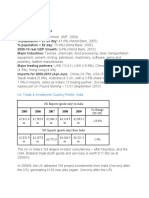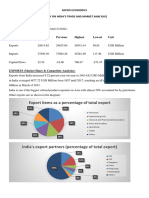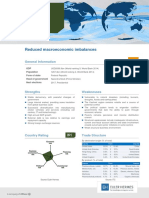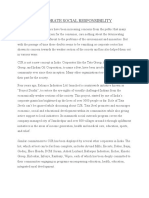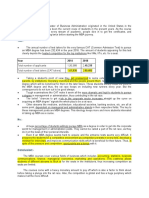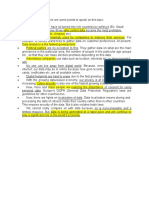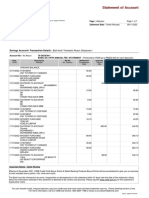Indian Economy
Indian Economy
Uploaded by
Sona DuttaCopyright:
Available Formats
Indian Economy
Indian Economy
Uploaded by
Sona DuttaOriginal Title
Copyright
Available Formats
Share this document
Did you find this document useful?
Is this content inappropriate?
Copyright:
Available Formats
Indian Economy
Indian Economy
Uploaded by
Sona DuttaCopyright:
Available Formats
Nominal GDP: 7th largest in the world; per capita= $2,134 (developed economy = $12,000 or more)
PPP: And 3rd largest; per capita= $7,783
the degree of economic development are gross domestic product (GDP), gross national product (GNP), the per
capita income, level of industrialization, amount of widespread infrastructure and general standard of living.
GDP by sector Agriculture: 17.32%
Industry: 29.02%
Services: 53.66% (2016 est.)
Inflation (CPI) 2.05% (January 2019)
Labour force by occupation Agriculture: 47%
Industry: 22%
Services: 31% (FY 2014 est.)
Main industries Textiles
chemicals
food processing
steel
cement
mining
petroleum
machinery
software
pharmaceuticals
transportation equipment
Ease-of-doing-business rank 77 (2019)
External
Exports $303.4 billion (2017–18)
Agricultural products 12.8%
Export goods
Fuels and mining products
13.8%
Manufacturers 70.5%
Others 2.9%
Main export partners European Union 17.4%
United States 16.1%
United Arab
Emirates 9.6%
Hong Kong 5%
China 4.2%
Other 47.8%
Imports $465.6 billion (2017–18)
Import goods Agricultural products 8.1%
Fuels and mining products
30%
Manufacturers 51.7%
Other 10.2%
Main import partners China 16.6%
European Union 10.4%
United States 5.7%
United Arab
Emirates 4.9%
Saudi Arabia 4.6%
Other 57.9%
Foreign reserves $400.2 billion (1 February 2019)[34](9th)
AGRICULTURE-
India ranks second worldwide in farm output. Crop-yield-per-unit-area of all crops has grown since 1950, due to the
special emphasis placed on agriculture in the five-year plans and steady improvements in irrigation, technology,
application of modern agricultural practices and provision of agricultural credit and subsidies since the Green
Revolution in India. However, international comparisons reveal the average yield in India is generally 30% to 50% of
the highest average yield in the world.
India is the largest producer of milk, jute and pulses, and has the world's second-largest cattle population with
170 million animals in 2011. It is the second-largest producer of rice, wheat, sugarcane, cotton and groundnuts, as
well as the second-largest fruit and vegetable producer, accounting for 10.9% and 8.6% of the world fruit and
vegetable production, respectively. India is also the second-largest producer and the largest consumer of silk,
producing 77,000 tons in 2005. India is the largest exporter of cashew kernels and cashew nut shell liquid (CNSL).
India has the second-largest amount of arable land, after the US, with 52% of total land under cultivation.
Irrigation facilities are inadequate, as revealed by the fact that only 46% of the total cultivable land was irrigated as
of 2016, resulting in farmers still being dependent on rainfall, specifically the monsoon season, which is often
inconsistent and unevenly distributed across the country.
MANUFACTURING AND INDUSTRY-
Industry accounts for 26% of GDP and employs 22% of the total workforce. According to the World Bank, India's
industrial manufacturing GDP output in 2015 was 6th largest in the world on current US dollar basis ($559 billion).
ENERGY SECTOR-
Primary energy consumption of India is the third-largest after China and the US with 5.3% global share in the year
2015. Coal and crude oil together account for 85% of the primary energy consumption of India. India's oil
reserves meet 20% of the country's domestic oil demand.
Oil and natural gas fields are located offshore at Bombay High, Krishna Godavari Basin and the Cauvery Delta, and
onshore mainly in the states of Assam, Gujarat and Rajasthan.
GEMS AND JEWELLERY-
India is one of the largest centers for polishing diamonds and gems and manufacturing jewellery; it is also one of the
two largest consumers of gold. After crude oil and petroleum products, the export and import of gold, precious
metals, precious stones, gems and jewellery accounts for the largest portion of India's global trade.
You might also like
- Signage MS 2558 - 2014 Full (Signange)Document87 pagesSignage MS 2558 - 2014 Full (Signange)Foot TootNo ratings yet
- Gujarat, Information TechnologyDocument32 pagesGujarat, Information TechnologyDeepak Pareek100% (9)
- Indian Economy OverviewDocument42 pagesIndian Economy OverviewAbbas AnsariNo ratings yet
- Amazon Invoice MonitorDocument1 pageAmazon Invoice MonitorSoumen MondalNo ratings yet
- Indian EconomyDocument2 pagesIndian EconomySona DuttaNo ratings yet
- Indian EconomyDocument2 pagesIndian EconomySona DuttaNo ratings yet
- Nominal GDP: 7 Largest in The World Per Capita $2,134 (Developed Economy $12,000 or More) PPP: and 3 Largest Per Capita $7,783Document2 pagesNominal GDP: 7 Largest in The World Per Capita $2,134 (Developed Economy $12,000 or More) PPP: and 3 Largest Per Capita $7,783Sona DuttaNo ratings yet
- Economic Conditions of IndiaDocument15 pagesEconomic Conditions of IndiaSonamNo ratings yet
- Indian EconomyDocument3 pagesIndian Economywaraich97No ratings yet
- Currency Indian Rupee (INR) 1 0.015 USDDocument38 pagesCurrency Indian Rupee (INR) 1 0.015 USDMekhajith MohanNo ratings yet
- Economy of India PDFDocument48 pagesEconomy of India PDFSugan PragasamNo ratings yet
- A Macroeconomic Analysis of IndiaDocument21 pagesA Macroeconomic Analysis of IndiaJehangir KhambataNo ratings yet
- Chemical Industry in China-FinalDocument48 pagesChemical Industry in China-Finalsandeep_scNo ratings yet
- Manthan Report - Pesticide SectorDocument28 pagesManthan Report - Pesticide SectorAtul sharmaNo ratings yet
- Trade in PakistanDocument22 pagesTrade in PakistanANJUM KHANNo ratings yet
- India's Share in World TradeDocument20 pagesIndia's Share in World TradeHamid HusainNo ratings yet
- Implications of Foreign Trade Policy and Facilitation of Foreign TradeDocument46 pagesImplications of Foreign Trade Policy and Facilitation of Foreign TradebrramyaNo ratings yet
- International Trade and Current Issues. Pakistan's Trading Partners Submitted To: Miss Muzzamil Hanif Submitted By: Habiba KausarDocument5 pagesInternational Trade and Current Issues. Pakistan's Trading Partners Submitted To: Miss Muzzamil Hanif Submitted By: Habiba KausarHabiba KausarNo ratings yet
- Sector Update - Chemical Industry - Aug 2019-201908291312319244043Document6 pagesSector Update - Chemical Industry - Aug 2019-201908291312319244043Krishna KumarNo ratings yet
- IP UK Manufacturing of Bulk DrugsDocument21 pagesIP UK Manufacturing of Bulk DrugsaveaNo ratings yet
- Union Is The Joint Economy of TheDocument18 pagesUnion Is The Joint Economy of ThePanosMavrNo ratings yet
- Pakistan IMPORT AND EXPORTDocument8 pagesPakistan IMPORT AND EXPORTMuhammad FarazNo ratings yet
- Indian Agrochemical IndustryDocument13 pagesIndian Agrochemical IndustryPavan UNo ratings yet
- Tanzania: Large Current Account Deficits But Strong GDP GrowthDocument2 pagesTanzania: Large Current Account Deficits But Strong GDP GrowthFiona Pot NillaNo ratings yet
- Importance of Textiles & Clothing Industry in Indian EconomyDocument12 pagesImportance of Textiles & Clothing Industry in Indian EconomyMuhammed NavazNo ratings yet
- Fertilizer Draft V.1 - Updated - 1611841077Document29 pagesFertilizer Draft V.1 - Updated - 1611841077Maria AghaNo ratings yet
- Trade in Pakistan: Submitted To: Sir Imam AliDocument8 pagesTrade in Pakistan: Submitted To: Sir Imam AliANJUM KHANNo ratings yet
- Economy of Iraq - WikipediaDocument1 pageEconomy of Iraq - Wikipediaangel.al.naqeeb1No ratings yet
- Economy of FranceDocument22 pagesEconomy of FrancePanosMavrNo ratings yet
- Poultry Value Chain: T. Nanda Kumar, Anisha Samantara, and Ashok GulatiDocument26 pagesPoultry Value Chain: T. Nanda Kumar, Anisha Samantara, and Ashok GulatiWasee AhmedNo ratings yet
- Agrochemical FicciDocument44 pagesAgrochemical FicciVenkatram PailaNo ratings yet
- International Trade of Bangladesh & Continental Profile of MncsDocument27 pagesInternational Trade of Bangladesh & Continental Profile of MncsRatul MahmudNo ratings yet
- Agrochemical FicciDocument44 pagesAgrochemical Ficcigee emmNo ratings yet
- Selamat Pagi Kawan, Selamat Datang Di Indonesia: Good Morning Friends, Welcome To Indonesia!Document22 pagesSelamat Pagi Kawan, Selamat Datang Di Indonesia: Good Morning Friends, Welcome To Indonesia!Shaneen Angelique MoralesNo ratings yet
- Economy of SingaporeDocument42 pagesEconomy of SingaporeRahuldev MeherNo ratings yet
- Economy of PeruDocument27 pagesEconomy of PeruAman DecoraterNo ratings yet
- Lecture 19Document28 pagesLecture 19bggimsNo ratings yet
- Bangladesh Economic OverviewDocument7 pagesBangladesh Economic OverviewHasan Imam FaisalNo ratings yet
- Indian Trade PolicyDocument13 pagesIndian Trade PolicyvivekNo ratings yet
- Indian Pharmaceutical SectorDocument15 pagesIndian Pharmaceutical Sectorvarunnitie100% (1)
- Indian Economy: A Comparative Overview With ChinaDocument63 pagesIndian Economy: A Comparative Overview With Chinaswat321No ratings yet
- Kingdom of MoroccoDocument53 pagesKingdom of MoroccoHafiz Kamran AhmedNo ratings yet
- Korean Medical Device 2020Document99 pagesKorean Medical Device 2020Pharmacist OneNo ratings yet
- Presented By: Abdul Hameed 01 Honey Balani 03 Manish Kamble 16 Rahul Pillai 38 Dhiraj Vinaykia 59Document38 pagesPresented By: Abdul Hameed 01 Honey Balani 03 Manish Kamble 16 Rahul Pillai 38 Dhiraj Vinaykia 59Shweta Raman SharmaNo ratings yet
- Effect of COVID-19 On The Indian Economy and Supply ChainDocument12 pagesEffect of COVID-19 On The Indian Economy and Supply ChainHrishabhNo ratings yet
- MICECO - Final ReportDocument5 pagesMICECO - Final ReportNikhil WadhwaniNo ratings yet
- Oil and Gas: Sector ProfileDocument21 pagesOil and Gas: Sector ProfileKalpitNo ratings yet
- 02 Nasir Javaid PDFDocument33 pages02 Nasir Javaid PDFUmer DhillonNo ratings yet
- Blameless in The Stratosphere (Ducanes, Daway, Ravago, Fabella) PDFDocument24 pagesBlameless in The Stratosphere (Ducanes, Daway, Ravago, Fabella) PDFStratbase ADR Institute100% (1)
- Country Report IndiaDocument2 pagesCountry Report IndiaSagar GuptaNo ratings yet
- Manufacturing of Biofertilizers and BiopesticidesDocument24 pagesManufacturing of Biofertilizers and Biopesticidesvikaspatidar78_27504100% (1)
- Market Analysis of ButanolDocument5 pagesMarket Analysis of ButanolMuhammad IqmalNo ratings yet
- English Annual Report Date 24-2-2020.......Document86 pagesEnglish Annual Report Date 24-2-2020.......pinakshiNo ratings yet
- Study Id67811 Waste Management in IndiaDocument70 pagesStudy Id67811 Waste Management in IndiaParva ChandaranaNo ratings yet
- Tracing - The - Business - Cycle - of - India - Since - The - PandemicDocument15 pagesTracing - The - Business - Cycle - of - India - Since - The - Pandemicsappyyadav1297No ratings yet
- Chapter-3 Nris Investment: Opportunities and GrowthDocument41 pagesChapter-3 Nris Investment: Opportunities and GrowthSwati GoudNo ratings yet
- Industry BDDocument8 pagesIndustry BDLabib AhsanNo ratings yet
- Indian Petroleum Industry ResearchDocument30 pagesIndian Petroleum Industry Researchabhijitsamanta1100% (3)
- Us Economy AssignmentDocument11 pagesUs Economy AssignmentThe MilindNo ratings yet
- The Global Action on Green Development of Special Agricultural Products: One Country One Priority Product: Action Plan 2021–2025From EverandThe Global Action on Green Development of Special Agricultural Products: One Country One Priority Product: Action Plan 2021–2025No ratings yet
- From Reference Levels to Results Reporting: Redd+ under the United Nations Framework Convention on Climate Change: 2020 UpdateFrom EverandFrom Reference Levels to Results Reporting: Redd+ under the United Nations Framework Convention on Climate Change: 2020 UpdateNo ratings yet
- Food Outlook: Biannual Report on Global Food Markets: November 2021From EverandFood Outlook: Biannual Report on Global Food Markets: November 2021No ratings yet
- Lubrication in EVsDocument3 pagesLubrication in EVsSona DuttaNo ratings yet
- Manu. Process and ThermoDocument10 pagesManu. Process and ThermoSona DuttaNo ratings yet
- Major Manufacturing Facilities: Collaboration / Technical Tie-UpsDocument11 pagesMajor Manufacturing Facilities: Collaboration / Technical Tie-UpsSona DuttaNo ratings yet
- NIT Sil DetailDocument1 pageNIT Sil DetailSona DuttaNo ratings yet
- Passenger Cars Industry Trend 18-19Document7 pagesPassenger Cars Industry Trend 18-19Sona DuttaNo ratings yet
- How Shock Absorber WorksDocument3 pagesHow Shock Absorber WorksSona DuttaNo ratings yet
- Packages With A Total of 14 Items. The Contracted Prices of 7 Items Were Higher Than The "Aligned Price", TheDocument1 pagePackages With A Total of 14 Items. The Contracted Prices of 7 Items Were Higher Than The "Aligned Price", TheSona DuttaNo ratings yet
- National Election ScheduleDocument2 pagesNational Election ScheduleSona DuttaNo ratings yet
- Engg. Q From TIMEDocument15 pagesEngg. Q From TIMESona DuttaNo ratings yet
- Castrol India Limited: Statement of Audited Financial Results For The Quarter and Year Ended 31 December 2018Document3 pagesCastrol India Limited: Statement of Audited Financial Results For The Quarter and Year Ended 31 December 2018Sona DuttaNo ratings yet
- Digital Payments in IndiaDocument3 pagesDigital Payments in IndiaSona DuttaNo ratings yet
- CSR - Source MBA RendezvousDocument3 pagesCSR - Source MBA RendezvousSona DuttaNo ratings yet
- Gen X Vs Gen YDocument3 pagesGen X Vs Gen YSona DuttaNo ratings yet
- Farm Loan Waivers - Good or BadDocument2 pagesFarm Loan Waivers - Good or BadSona DuttaNo ratings yet
- Is MBA A Rat RaceDocument1 pageIs MBA A Rat RaceSona DuttaNo ratings yet
- Data Is The New OilDocument1 pageData Is The New OilSona DuttaNo ratings yet
- Person-Theresa Adamson NJ-07 25 2020Document118 pagesPerson-Theresa Adamson NJ-07 25 2020sportsnewsnet1000No ratings yet
- Macro-Organisational Behaviour: Final Project, Group 4Document19 pagesMacro-Organisational Behaviour: Final Project, Group 4Arsheen Kaur ChughNo ratings yet
- 5awrite About The Classification of Public Debt. Explain The Essentials of Good Budget.Document3 pages5awrite About The Classification of Public Debt. Explain The Essentials of Good Budget.v kNo ratings yet
- KM0014 49Document2 pagesKM0014 49Abhay Kumar JhaNo ratings yet
- Chapter 5 - The Five Generic Competitive Strategies - Orbegoso, Aira Coleen R.Document26 pagesChapter 5 - The Five Generic Competitive Strategies - Orbegoso, Aira Coleen R.Coleen OrbegosoNo ratings yet
- Accounting For CorporationsDocument24 pagesAccounting For Corporationsroselynm18100% (1)
- Maersk - ONE - Sealand - HapagDocument10 pagesMaersk - ONE - Sealand - HapagAgro Export and importNo ratings yet
- 2 CA Foundation Companies Act2013 Scanner NRK AcademyDocument47 pages2 CA Foundation Companies Act2013 Scanner NRK Academypapai01personalNo ratings yet
- Business Economics - Assignment 1Document2 pagesBusiness Economics - Assignment 1Sachin ThakurNo ratings yet
- Theft ExtortionDocument37 pagesTheft ExtortionrajammalsupramaniamNo ratings yet
- 2014 AllslipsDocument3 pages2014 Allslipsapi-652848320No ratings yet
- The Role of Cryptocurrencies in Investor PortfoliosDocument15 pagesThe Role of Cryptocurrencies in Investor Portfoliossiquanmo123No ratings yet
- 5 Updated Course Outline Civil Law Review2Document25 pages5 Updated Course Outline Civil Law Review2Christy SanguyuNo ratings yet
- So N Unit 9Document8 pagesSo N Unit 9Lam TrúcNo ratings yet
- Sas4 Fin 055Document18 pagesSas4 Fin 055Mykaila ValdezNo ratings yet
- 해커스토익 전미정선생님 2020년 7월 적중예상문제Document7 pages해커스토익 전미정선생님 2020년 7월 적중예상문제Tae Kwan LeeNo ratings yet
- L6 - Cost Accounting PrinciplessDocument36 pagesL6 - Cost Accounting PrinciplesshayliyesusNo ratings yet
- (Original Size) StoryBizz by Atelierish Media PR OfferDocument16 pages(Original Size) StoryBizz by Atelierish Media PR OfferAbhishek GoyalNo ratings yet
- Variable Costing'Document22 pagesVariable Costing'2023-2-95-013No ratings yet
- Actividad 6 Plantilla Dinámica e Informe de Análisis EmpresarialDocument13 pagesActividad 6 Plantilla Dinámica e Informe de Análisis EmpresarialNancy Esther SARMIENTO CARRENONo ratings yet
- FFIList PartialDocument133 pagesFFIList Partialtonys71No ratings yet
- Express Auto's Current Compensation SystemDocument1 pageExpress Auto's Current Compensation SystemSujit KumarNo ratings yet
- Make Wire Transfers Through Online Banking From AnywhereDocument2 pagesMake Wire Transfers Through Online Banking From AnywhereDani PermanaNo ratings yet
- Passion Reborn at BOP: Home Remittance DepartmentDocument2 pagesPassion Reborn at BOP: Home Remittance DepartmentSami UllahNo ratings yet
- NovemberDocument7 pagesNovemberMuhammad IqbalNo ratings yet
- 2023 05 29 PH e PgoldDocument7 pages2023 05 29 PH e PgoldexcA1996No ratings yet
- Immersion Project FinalDocument14 pagesImmersion Project FinalTHE 4No ratings yet
- Bju LJN Exp Sleeper Class (SL)Document1 pageBju LJN Exp Sleeper Class (SL)fkaisharNo ratings yet








